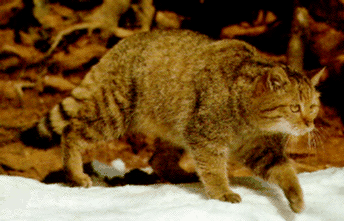

Name: European Wildcat
Species: Felis Silvestris
Weight: 10-30 pounds
Head/Body: 22-28 inches
Tail: 12 inches
Subspecies: 7
An older species, evolving about 650,000 years ago, the European wildcat is in the direct ancestral line of the domestic cat (our cats) and is the parent species for several related small cats, most notably Felis lybica, which it strongly resembles. It is about one- third larger than a feral domestic cat and resembles it in both build and coat. It is often mistaken for a large tabby with disastrous results, as it is not at all friendly (somewhat vicious, in fact). Its coat is long and thick, to protect it from harsh European winters, and is colored and marked identically to a basic brown striped-tabby alleycat.
The European wildcat may be found in all parts of Europe and Asia west of the Urals and the Caspian except the arctic. It is not afraid of humans and will live on the outskirts of cities scavenging in garbage bins (much as do raccoons and coyotes in the U.S.) . It is very prolific and a long way from being endangered, even though its territory is diminishing as more and more of Europe is converted to city and suburbs. It hunts by twilight, from the ground, and seeks rats, squirrels, birds, small deer, domestic cats, small dogs, and poultry. It is usually considered vermin by farmers and villagers.

